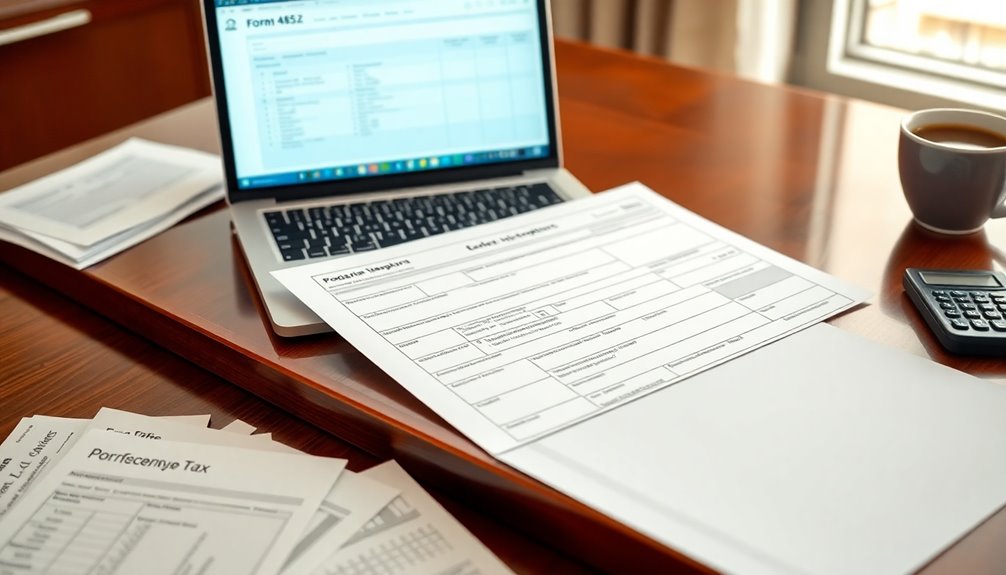You can file your taxes without a W-2 or 1099 by using Form 4852 as a substitute. First, estimate your income and withholdings based on your last pay stub and gather essential details like employer information and total earnings. Fill out Form 4852, and attach it to your tax return before submitting. If you're self-employed, report your income on Schedule C. Make sure to keep copies of all documents for future reference. If you're unsure about the process or need further guidance, there's more to explore to ensure you nail your tax filing correctly.
Key Takeaways
- Use Form 4852 as a substitute for missing W-2 or 1099 forms and attach it to your paper tax return.
- Estimate your income and tax withholdings based on your last pay stub if exact figures are unavailable.
- Gather all necessary information such as employer details, total wages, and any other income sources before filing.
- Report self-employment income on Schedule C and calculate self-employment tax using Schedule SE if applicable.
- Retain all tax documents for at least three years to prepare for potential audits or inquiries.
Obtaining Necessary Forms

When it comes to filing your taxes, obtaining the necessary forms is crucial, especially if you haven't received your W-2 or 1099. Employers are required to provide W-2 forms by January 31, so if you haven't received yours, reach out to your employer directly to request a copy.
If they don't respond, you can call the IRS helpline at +1-(800)-829-1040 for assistance. For those living outside the US, the IRS American Abroad helpline at +1 (267) 941-1000 is available.
If you're an independent contractor, your payments should be reported on Form 1099-NEC, which payors also need to provide by January 31. If you haven't received it, contact the payor to request a copy.
When you do get your 1099, ensure it's the right type and that all entries are accurate before filing your taxes. Remember, companies must properly classify workers as employees or independent contractors to issue the correct forms. This classification is essential for accurate tax reporting obligations.
If your employer opts for electronic forms, ensure you've given them consent. By following these steps, you'll be better prepared for tax season.
Using Form 4852

If you find yourself without a W-2 or 1099-R by February 15, Form 4852 can come to your rescue as a substitute. This form is designed for situations where you haven't received your W-2 or 1099-R, or if the information on those forms is incorrect.
To use it correctly, you'll need to attach Form 4852 to your paper tax return, as it can't be e-filed directly. Start by downloading Form 4852 from the IRS website or obtaining a copy at a local IRS office. Fill out your full legal name, address, and Social Security number in the first few lines. Specify which form is missing in line 4, and include your employer's information.
It's essential to estimate your income and tax withheld based on your last pay stub if you don't have precise figures. Filing Form 4852 ensures compliance with IRS income reporting requirements. Ensure you sign and date the form to validate it; otherwise, it won't be accepted. Once completed, attach Form 4852 to your tax return and mail it to the IRS.
Keep a copy for your records, especially for Social Security verification in the future.
Gathering Required Information

Gathering the necessary information to file your taxes without a W-2 or 1099 can seem daunting, but it's essential for ensuring an accurate return. Start by collecting details about your employer, including their name, address, and Employer Identification Number (EIN). Document your type of employment, job title, and the dates you worked.
Next, track your total wages, any tips received, and other forms of compensation like bonuses and overtime. Don't forget to include information on tax withholdings such as federal, state, and local income taxes. If you have additional income sources—like unemployment benefits or gambling winnings—make sure to gather records for those as well. Pay stubs are crucial; gather your final pay stubs and any monthly statements to verify your earnings.
For expense deductions, collect receipts for things like childcare, education, and charitable donations. If you're self-employed, keep records of any 1099 forms and business expenses. Additionally, if you haven't received your W-2, you may need to use Form 4852 as a substitute to estimate your wages and withholdings.
Lastly, consider requesting wage and income transcripts from the IRS for verification. This comprehensive collection of information will set you up for a smoother tax filing experience.
Filing Taxes Without Forms

Filing taxes without traditional forms like a W-2 or 1099 can be challenging, but it's entirely possible with the right approach. If you haven't received your W-2, you can use Form 4852 as a substitute. You'll need to estimate your total wages and withholding based on your final pay stub. Remember, Form 4852 must be attached to a paper tax return that you mail, as e-filing isn't permitted. Expect some delays in processing since the IRS might contact your employer for the missing W-2.
For self-employment income, you won't receive a W-2. Instead, use Form 1099-NEC if your payments exceeded $600. Report your earnings on Schedule C and calculate self-employment tax using Schedule SE. It's essential to keep accurate records of your income and expenses because all employees receiving wages are entitled to a W-2, and this applies even if you are self-employed.
Make sure to estimate and pay your taxes quarterly to avoid penalties. If you're missing a form, first contact your employer's payroll or HR department. If they don't respond by late February, call the IRS helpline at +1-800-829-1040. You can also request a Wage and Income Transcript from the IRS to verify your income. Always report all income to ensure compliance and avoid penalties.
Organizing Tax Records

Organizing your tax records efficiently can save you time and reduce stress when tax season arrives. Start by gathering all necessary documents in one place, like bank statements, investment records, and any income forms such as W-2s or 1099s.
Create a filing system that works for you—whether it's a physical filing cabinet or a cloud-based service. Label each document clearly, organizing them by year or category for easy retrieval.
Categorize your tax documents into sections like income, assets, and deductions. This includes statements related to loans, investments, and receipts for work-related expenses or charitable donations. Organized records ensure accurate and efficient tax filing, helping you avoid potential issues with the IRS.
Make sure all documents are accurately dated and include details like the amount and type of expense.
For secure storage, use locked filing cabinets for physical documents and strong passwords for digital files. Regularly update your records and maintain organization throughout the year to avoid last-minute chaos.
Consider using tax software to help import financial records and streamline your filing process. By staying organized, you'll find it much easier when it's time to file your taxes.
Understanding Potential Consequences

Not receiving or filing a W-2 or 1099 can lead to significant consequences that you should be aware of. If you file late, you could incur penalties ranging from $60 to $330 per form, depending on how late it is. These penalties can add up quickly, especially if you fail to withhold taxes from wages.
If you underreport your income, the IRS may impose an accuracy-related penalty of 20% on the underpayment. For instance, a $5,000 underpayment could cost you an extra $1,000 in penalties. Furthermore, you'll need to file an amended return to correct any mistakes, which must be done within three years. It's important to note that multiple W2 forms may arise from having multiple jobs, so tracking job changes is essential during tax season.
Misclassification of workers can also lead to severe penalties, including personal liability for unpaid taxes. If the IRS deems the misclassification intentional, penalties could escalate to 20% of wages plus all FICA taxes, with no maximum limit.
Finally, failing to include 1099 income can result in an understatement of tax liability. This means you may face reduced refunds or even additional taxes owed, emphasizing the importance of accurate reporting.
Next Steps After Filing

After you've submitted your tax return, it's essential to keep an eye on the processing status and be prepared for any potential amendments.
If you used Form 4852, the IRS may take longer to process your return since they need to verify the information with your employer's records. Remember, Form 4852 can't be filed electronically, so you'll want to monitor your paper submission closely.
If you receive a W-2 after filing, check if the information differs from what you reported. If it does, you'll need to amend your return using Form 1040-X. Be mindful of the statutory time limits for filing amendments, and consider using tax preparation software like TurboTax to simplify the process. Multiple W-2s may be issued if you have changed jobs or have multiple employments, so keep that in mind when reviewing your documents.
Don't forget about state and local tax obligations. Each may have different rules for filing without a W-2. You might need to provide year-end pay stubs showing state and local withholding, so contact your local tax department for specific requirements.
Lastly, keep all tax-related documents for at least three years. This includes Form 4852, pay stubs, and any communication with the IRS or your employer to ensure you're prepared for future audits or inquiries.
Frequently Asked Questions
Can I Use Online Tax Software Without a W-2 or 1099?
You can use online tax software without a W-2 or 1099, but you'll need to gather your income information manually.
Estimate your wages from your final pay stub and include necessary details like employer's name and taxes withheld.
Keep in mind that while you can e-file without the physical forms, discrepancies may lead to delays or audits.
Consider requesting wage transcripts from the IRS for additional accuracy and support.
What if I Lost My Last Pay Stub?
If you've lost your last pay stub, don't worry; you can still estimate your income.
Contact your employer and request a copy of the pay stub or W-2. If they don't respond, reach out to the IRS for help.
You can use your final pay stub's information to estimate your wages for tax filing. Just keep track of what you estimate for your records and future reference.
How Do I Estimate My Income Accurately?
To estimate your income accurately, gather all your earnings from various sources, including any side jobs or freelance work.
Add up any cash income, and don't forget to include rental income or investments. Use bank statements and receipts to verify these amounts.
If you're self-employed, calculate your net income by subtracting allowable expenses.
Utilizing tax preparation software can also help streamline this process and ensure you capture all your income accurately.
Can I File Taxes if I Worked Multiple Jobs?
Yes, you can file taxes if you worked multiple jobs.
You'll need to report all your income on a single federal tax return, regardless of how many jobs you had. Gather your pay stubs and any records of income.
Even without W-2s or 1099s, you must include all earnings from part-time jobs and freelance work.
Use Form 1040 to report everything accurately, ensuring you don't miss any income sources.
What if My Employer Refuses to Provide a W-2?
If your employer refuses to provide a W-2, start by contacting their payroll or HR department to check the status.
Make sure they've your correct mailing address.
If they still don't cooperate, use your final pay stub to estimate your wages and fill out Form 4852.
You can also reach out to the IRS for assistance and report the issue to ensure your income is properly accounted for.
Conclusion
Filing taxes without a W-2 or 1099 can be daunting, but you've got options. By using Form 4852 and gathering the necessary information, you can still file your taxes accurately. Just remember to keep your records organized and be aware of any potential consequences. Once you've submitted your return, stay proactive about any follow-up needed. With a little effort, you can navigate this process and ensure you're meeting your tax obligations successfully.









